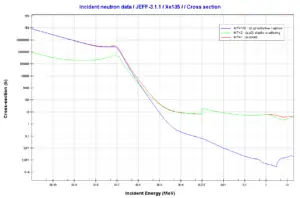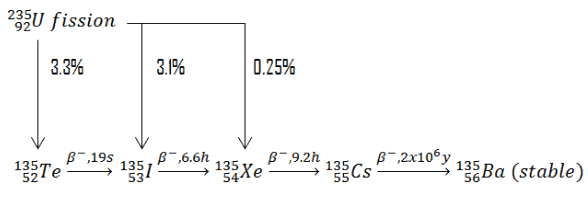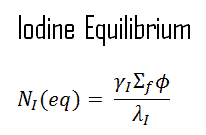Iodine 135

Source: JANIS (Java-based Nuclear Data Information Software); The JEFF-3.1.1 Nuclear Data Library
As was written, xenon 135 has a tremendous impact on the operation of a nuclear reactor. Xenon-135 is a product of U-235 fission and has a very large neutron capture cross-section (about 2.6 x 106 barns). It also decays radioactively with a half-life of 9.1 hours. Little of the Xe-135 results directly from fission, but most comes from the decay chain, Te-135 (β– decay, 19 sec) to I-135 (β– decay, 6.6 hr) to Xe-135. The instantaneous production rate of xenon 135 is dependent on the iodine 135 concentration and therefore on the local neutron flux history. On the other hand, the destruction rate of xenon 135 is dependent on the instantaneous local neutron flux. Its significance is primarily caused by two factors:
- its enormous capture cross-section
- its ultimate total yield, which is about 6.3%
In a typical nuclear reactor fueled with uranium 235, the presence of 135Xe as a fission product is of the highest importance in the power operation. At zero-power operation the presence of 135Xe may be neglected, since its concentration is very low. At power operation the situation is different.
Engineers and operators must perfectly know behaviour of a reactor with xenon 135. They are trained to properly anticipate and react to the transients induced by equilibrium or non-equilibrium xenon distribution. The presence of 135Xe is associated with the following operational issues:
- Equilibrium Xenon – Xenon Poisoning
- Equilibrium Xenon for Different Power Levels
- Response to Reactor Power Changes
- Iodine Pit – Response to Reactor Shutdown
- Spatial Xenon Oscillations
To understand these issues, we have to perfectly understand the production and removal of xenon 135.
Equilibrium Iodine
We hope, this article, Iodine 135, helps you. If so, give us a like in the sidebar. Main purpose of this website is to help the public to learn some interesting and important information about radiation and dosimeters.


